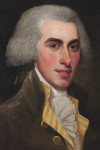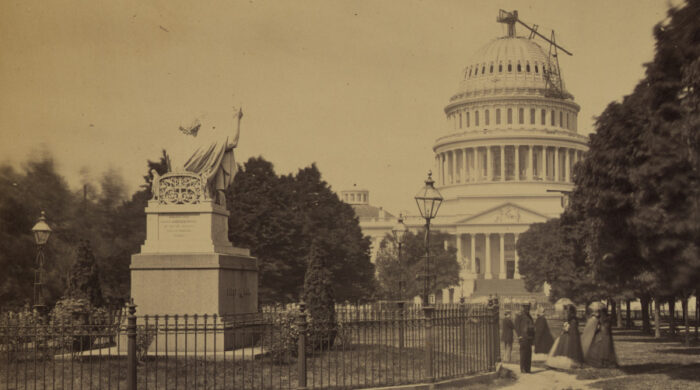
When we last looked at Horatio Greenough’s statue of George Washington, it was parked at the Navy Yard, and plans were afoot to bring it to the Capitol. This required some preparation, as the best way to move it was by water, using the still-extant canal to float it to a point closest to the Capitol. This took five days and was orchestrated by William Easby. Finally on December 1, 1841, it was placed on its pedestal in the center of the Capitol rotunda. This effort was crowned by three hearty cheers from the assembled crowd.
As to the statue itself, public opinion continued to be negative. A wag said that it looked like Washington had just awoken and grabbed only a sheet as he arose. As eminent an architect as Charles Bulfinch [above] made his dismay clear in a letter to his son:
[I]t may be an exquisite piece of work, bit our people will hardly be satisfied with looking on well developed muscles. When they wish to see the great man as their imagination has painted him. I send you a sort of defense of this statue from Everett, but am not convinced that the sculpture is suited for modern subjects; the dress presents insuperable difficulties.
Even Greenough was unhappy, though not exactly with the statue, but its placement. He felt that its location in the very center of the Capitol rotunda was inappropriate, due to the lighting.

Unsurprisingly, this did not end the controversy. About a half year after the unveiling, the public gardener, James Maher, came up with a solution: Move it outside. The newspaper Madisonian enthusiastically agreed.
Instead of confining the gigantic statue of Washington to the narrow limits and obstructed light of the rotunda, he proposes to place it over the central entrance of the enclosure to the grounds, on the west side, accompanied by a suitable pedestal, supported by an arch, decorated in such a manner as to be worthy of the high conceptions of the merits of the statue itself, as formed by its admirers.
The following year, Greenough threw in the towel, requesting his statue be moved. An enclosure for it was built on the east front of the Capitol. The statue, however, was not decorated in the manner that Maher had suggested. Instead, the Alexandria Gazette quoted an unnamed writer who said that it “resemble[d] more a rude and bloated expansion of a sentry box.” A few months later, in the same newspaper, a writer using the pseudonym “Pericles” added that it was “a miserable shed, more fitted for a cow house.”
And yet, this is where the statue remained for the next 60 or so years, with the “miserable shed” being used for the first few years, then replaced with a temporary one that was only used during the winter to protect it. Eventually, though, with the opening of the New National Museum – today the Natural History Museum – a proper space for it was made. It had, according to a contemporary article in the Evening Star by James Croggan, survived its time outside quite well, except for the expected weather effects – and a toe that had been broken off and replaced.
